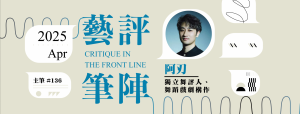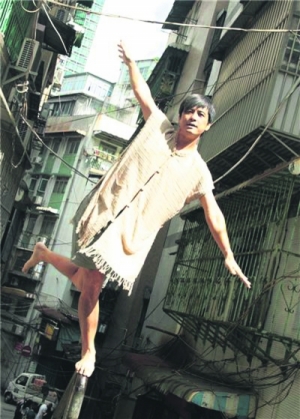Singapore Chinese Orchestra (SCO) is the only professional Chinese orchestra in Singapore. Singapore is well known for its multi-cultural environment. In order to capture this unique cosmopolitan feature, SCO took a twofold role in producing music. While they are keeping the traditional essence, they also push the musical boundaries further with the incorporation of Southeast Asian elements. In 16th to 18th Oct, 2015, SCO had toured Hong Kong and devoted two concerts to the local audience. In the second concert, they featured five Chinese orchestral pieces.
Thunder in a Drought, a well-known tune among the Cantonese-speaking region, commenced the concert. This was a good piece to start with since most of the audience might be familiar with that. As for Cantonese music, this genre has never shy away towards the incorporation with Western instruments. In this particular arrangement, jazz drums were employed. Began with the drum set, the plucked strings added on to provide a pulsating element, and lastly high sustaining notes on the bowed string were heard. After successive entries of these different orchestral layers, the main signature tune entered. This arrangement effectively displayed exchanges among the instruments. As to capture the typical essence of a jazz performance, this arrangement featured an improvisation-like soloistic section in the middle of the piece. These passages were performed in a relax and enjoyable manner, and were well connected in a tight way. The audience could also hear the attempts on imitating some jazz instruments: with suonas resembling jazz trumpets, and guanzis resembling saxophones. The skilful articulation and manipulation of embouchure had created a jazzy timbre on these winds. The use of jazz elements indeed fits very well with Cantonese tunes. Since Cantonese music had a history on a subgenre namely “spirit music,” which heavily adapted instruments and idioms from jazz music.
Izpirazione II – Rambutan by Simon Kong Su Leong, as suggested by its exotic title, some Nanyang flavour was expected in the piece. This short movement, a three-minute-ish section, blended exotic modes with Chinese Suzhou pingtan. It featured many short gestures, which were skilfully put together among the instruments. Also this light composition contained many simultaneous and interlocking lines among parts. The orchestral parts were well balanced, and the fragmentary materials were displayed with authenticity.
Tan Dun’s Fire Ritual called for huqin solo, orchestra, and offstage performers. The huqin soloist Baoshun Li had demonstrated his excellent skills on the instruments. Since the playable string lengths are different on various huqins, it might post difficulties on performers who have to quickly swap between the huqins. Nevertheless, Li had successfully demonstrated his excellency on mastering the instruments. Hong Kong Cultural Centre, despite its infamous narrowness among the audience seats, served a perfect venue for allocating the off-stage performers in this particular piece. The off-stage players, designated in a fan-shape manner, were well situated at each of the entry of the concert hall. The sonic outcome was hence able to surround the audience, and effectively interacted with the on-stage orchestra. Regardless of the distance and separation between the on-stage and off-stage groups, their interactions were perfectly coordinated. The orchestral members had demonstrated their rapports at their best in this particular piece. With Maestro Yeh’s precise conducting, the distanced call-and-responses were flawlessly achieved. This piece was indeed challenging to the conductor as well. Yeh was required to coordinate with the scattered performers. Such setting was highly unconventional in standard concert repertoires. At the same time, he had certain vocalised passages to be performed while conducting. Maestro Yeh had managed well this multi-tasking role. These fascinated settings impressively concluded the first half of concert.
Kaki means “leg” in Malay. Mahjong Kakis is hence a word created by code-mixing, as one would encounter a lot in Singlish language. Eric Watson, a UK composer who had resided in Singapore for twenty-four years, adopted this term as the title. Without the programme note, one could hardly imagine that the music indeed attempted to depict the scene of playing Mahjong. Audience would expect some sorts of exoticness in the piece, as one would possibly deduce from the code-mixed title. In contrary, the composition was composed totally with Western idioms, with no single dash of Chinese-ness or Southern Asian flavour. The piece sounded very stylish and trendy instead. It might suit very well when accompanying some documentaries: particularly videos that film about the cosmopolitan lives in Singapore, or some night scenes in the city.
The final piece Marco Polo and Princess Blue was scored for solo tenor and soprano, Chinese orchestra, chorus, and children’s chorus. Warren Mok, Bixia Wu, Opera Hong Kong Chorus, and Opera Hong Kong Children Chorus took part in the choral passages. SCO had a long history on performing this symphonic poem by Yuan Liu, since their debut in 2002 at the opening festival of Esplanade – Theatres on the Bay. The orchestral part strived their best accompanying the vocalists. It had not overshadowed any of the vocal passages, while the choral parts were yet to be improved. Several spots were obviously noticeable for some flaws. It was heard that in the tenor parts, a particular voice had popped out throughout the opening movement. The opening treble voice was found thin in timbre and flattened in pitch. Also instability in timbre was noted in the chorus part. Possibly the chorus was not so familiar singing with Chinese instruments. A vocalised passage, which consisted the only syllable “la,” was repeatedly heard several times in the children’s chorus part. Their entries were of mismatch to the orchestra. The group did not attempt to follow closely the tempo and cues of the conductor. It was understandable that the rehearsal time might be quite limited. It was also debatable whether the two vocalists actually needed the amplifications, since they were both experienced in opera singing. The tenor’s amplification was a bit faulty, and some unwelcoming hissing timbre was noticed throughout. Also the inhaling sound was unintentionally amplified. Despite these, Wu, the soprano, did well in conveying the story through her voice. She sang without the use of score, and was able to express naturally accordingly to the text. She was indeed the soprano solo who debuted the same piece with SCO in the above-mentioned festival. Obviously she had well managed her part and her interactions with the orchestra. Nonetheless, the orchestra had kept their well shape throughout the concert and won positive responses from the audience.
The enthusiastic audience eagerly applauded for the gorgeous performance, in return, SCO devoted three encores to the Hongkongers. The first one was Under the Lion Rock, one of the most representative songs in Hong Kong. Before the music actually started, Maestro Yeh had invited the audience to guess the name of the song, displaying his passion and willingness to interact with the audience. Despite that the same song was encored in the previous night’s concert, the audience remained happy and enthusiastic to hear this tune. The second encore was a set of horse-themed compositions. It light-heartedly started with American composer Leroy Anderson’s Horse and Buggy. The orchestra nicely captured the lightness in the piece, and vividly depicted a playful atmosphere. The choice of this little tune was also perfect, as Anderson was a composer that focused on composing light concert piece. The original score employed extensive use of woodblocks that was clearly inspired by horse galloping. The Chinese orchestral version adopted so, and sounded perfectly when paired with the Chinese instruments. This miniature was then transited to the famous Chinese counterpart, where Haihuai Huang’s Horse Racing (“Saima”) was heard. This upbeat work brought the music to a cheerful ending.
Having met and fulfilled the Hong Kong audience’s expectation, Maestro Yeh and the orchestra delivered the final encore. Yeh linked this upcoming piece with the coziness of Hong Kong in the midnight time. He also warmly introduced one of the sheng soloists Mr. Kevin Cheng, a Hong Kong player who now residing in SCO, so to display him under the spotlight. This last encore, which again demonstrated the metropolitan side of SCO, was the popular tune Can’t Take My Eye Off of You. This fashionable tune filled the concert hall with a chic atmosphere. The use of bongos, jazz drums, and shakers perfectly decorated the tune with a cozy mood. The laid-back and classy performance concluded the night with loads of cheerfulness.
The concert repertoires this night were in fact presented in the their orchestral season 2015 namely “Essence of Nanyang”. Clearly could the audience notice the intention of including South-east Asian flavours into the concert. Yet surprisingly this title was missing in any of the promotion materials in Hong Kong, including the concert booklet. Nevertheless, SCO as a multi-dimensional musical messenger had brought their leading-edge visions to the Hong Kong audience. The fusion of cosmopolitan style with Nanyang-ness had successfully created a unique sonic signature with the Chinese instruments. Under the baton of Maestro Yeh, the orchestra will surely continue to explore and expand the possibilities in Chinese orchestral repertoires.
本網站內一切內容之版權均屬國際演藝評論家協會(香港分會)及原作者所有,未經本會及/或原作者書面同意,不得轉載。










